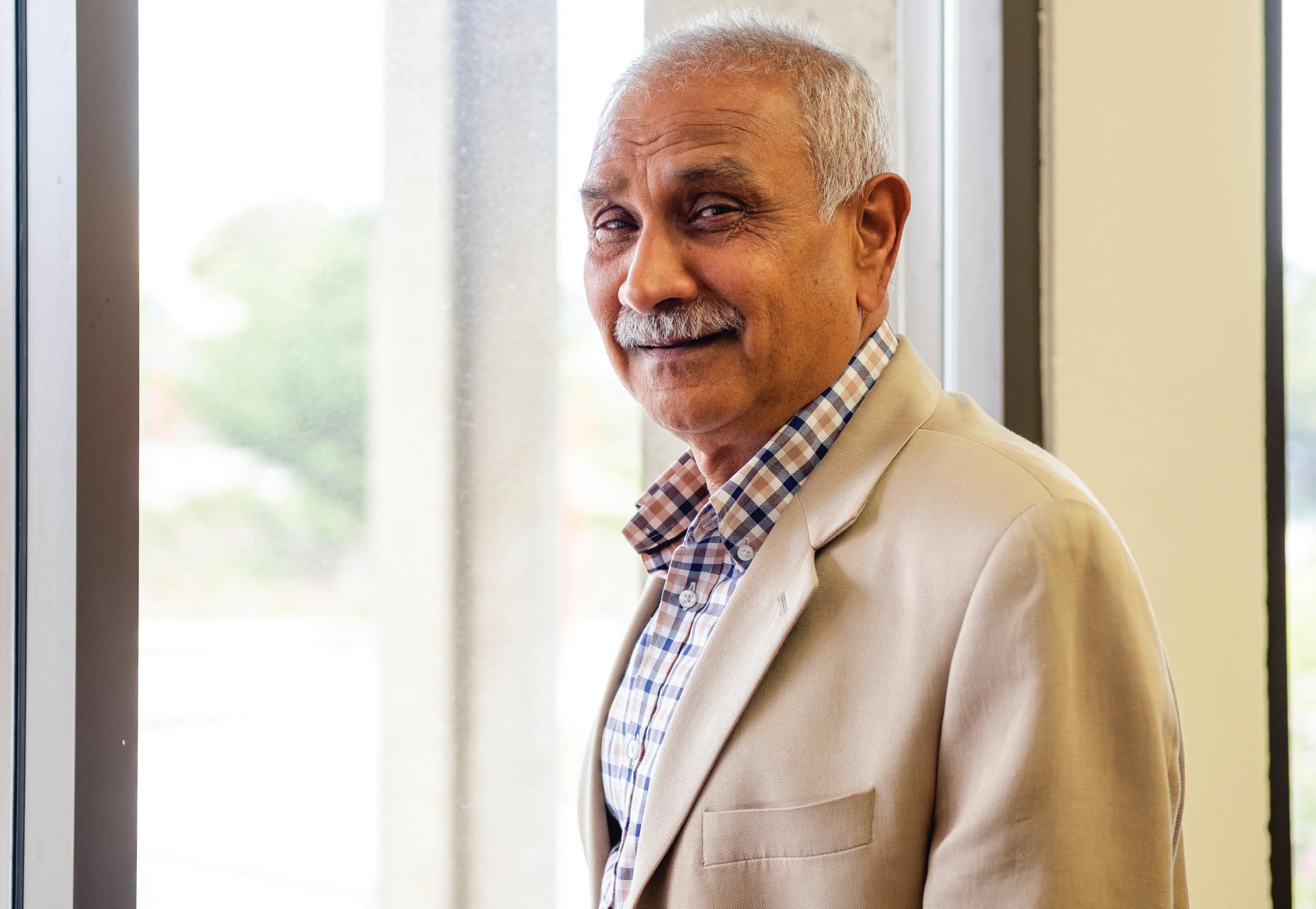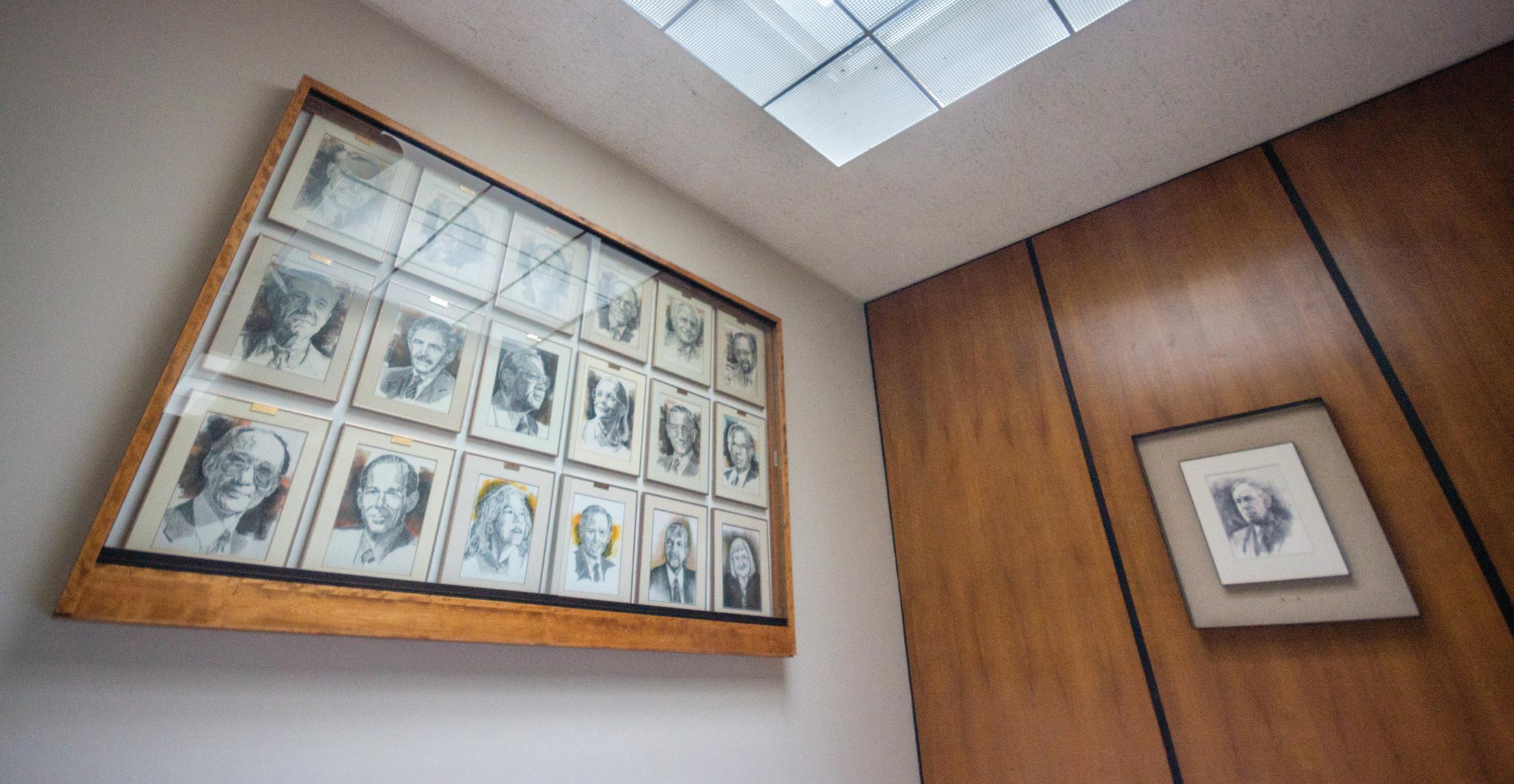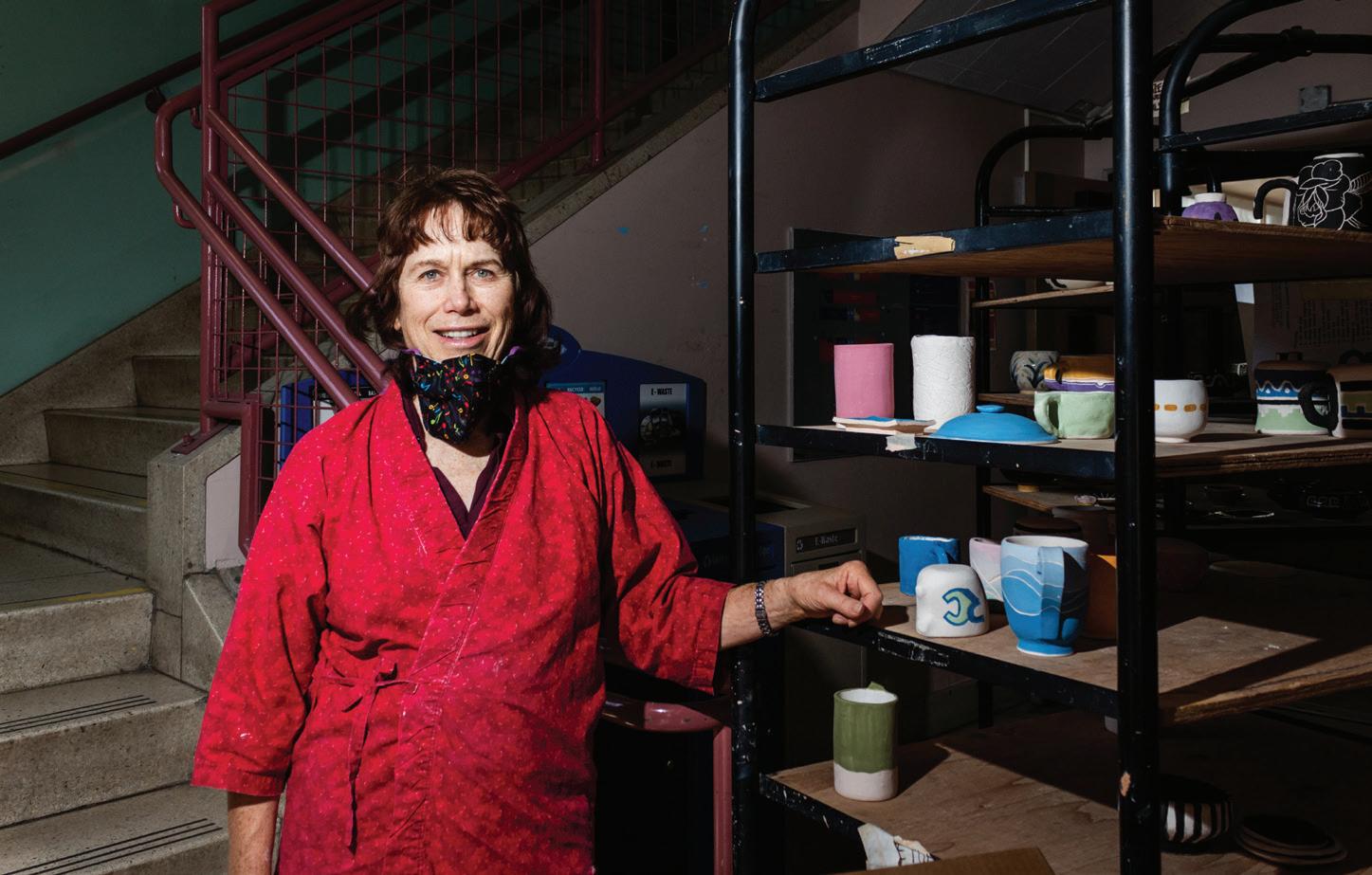
30 minute read
Here We Go Again
Board of trustees postpones the chancellor search in face of a looming budget deficit
Story by Abraham Davis Photography by Emily Trinh and Bo Lenschau
Advertisement
And just like that, City College of San Francisco is again in need of a permanent chancellor. Previous Chancellor Mark Rocha resigned from the position on March 21, 2020, leaving behind a trail of controversy as well as a gaping and ever-growing hole in City College’s budget deficit. The school’s board of trustees, BOT, must now find a willing individual to take the helm and steer City College through the extreme turbulence that perpetually surrounds it.
Finding this individual is proving to be more difficult than previously expected. The BOT has now postponed the search until July 1, 2021, after closing the initial application pool on March 12, according to a mass email sent by BOT President Shannell Williams on March 16.
“This new timeline also will allow us to recruit more candidates with the executive-level experience and desired qualifications described in our position announcement,” she says in the email.
The public posting for the position states that the BOT is seeking “a respected, experienced leader with a strong professional reputation to provide unifying and participatory leadership to this dynamic, complex, urban, and diverse district.”
There is no mention of salary range on the posting. It only states that “Total compensation includes a health insurance plan,” and “New employees hired on or after Jan. 1, 2014 will contribute 2% of salary to the San Francisco Retiree Health Care Trust Fund.” The average chancellor salary in California is $316,000. The last City College chancellor salary on record is Mark Rocha’s at $354,000 in 2019.
Other open chancellor positions are also vague when it comes to salary. For instance, in the Kern Community College district chancellor application, the only detail given about the minimum salary range is “Salary is competitive and commensurate with experience and negotiated with the Board.” Filling the seat “is arguably the single biggest responsibility the board has,” said Tom Temprano, Vice President of the BOT in an Examiner article published in January 2021. “The lack of stability and continuity in that position is a real problem.”
He makes an important point. For over a decade, City College has been unable to hold a permanent chancellor for longer than four years. This trend began in 2008 after Chancellor Philipp Day pleaded guilty to three of eight felony charges, all surrounding the misuse of public funds and illegal campaign contributions.
According to an article published in the Examiner in September 2011, prosecutors accused Day “of illegally diverting about $100,000 of money to fund political campaigns for measures benefiting community colleges in 2001, 2005 and 2006. He also was accused of maintaining a secret account to pay for parking
“Without placing blame on either side, I think there is a level of trust that needs to be built up.” — Alan Wong
The City College chancellor’s office is in Conlan Hall on Ocean Campus. (Bo Lenschau/Etc Magazine)

Interim Chancellor Dr. Rajen Vurdien poses in his office in Conlan Hall on Ocean Campus. Vurdien now plans to step down in October. (Emily Trinh/Etc Magazine)
tickets, alcohol at functions and a maintain a balanced budget. In an SFgate A couple months after the membership at an exclusive business club.” article published in 2012, English announcement, Art Tyler was named
According to an article published in instructor Alisa Messer said of Griffin, the new permanent chancellor of City SFgate in March 2012, Day was fined “He’s done the best he can do in a College. Tyler was a former president of $30,000 and sentenced to a five-year tremendously difficult situation to try Sacramento City College and had also probation. He had served as chancellor to serve students and protect employees served as a state-appointed trustee at of City College from 1998–2008. at the college.” Compton College, another community
Day was followed by Chancellor Don Between permanent chancellors, college riddled with accreditation issues. Griffin. Griffin was dealt a tough hand. the BOT placed Pamila Fisher as Tyler would end up resigning. He was He was not only given the interim chancellor. In this period, the reassigned to the facilities department 19 responsibility of months after his renewing City College’s reputation, but he also had to “Unless we can stem the bleeding right now and plan for the next four years, there will be serious initial hire when it was revealed that he had spent a third of navigate the college through the 2008 problems.” — Rajen Vurdien his tenure as chancellor off-campus, economic crash. traveling and dining He had to make difficult decisions, Accrediting Commission for Community at high-end restaurants, letting the college including cutting many part-time and Junior Colleges, ACCJC, sanctioned pay for the expenses. classes as well as summer school for an City College under a Show Cause status After Tyler came Interim Chancellor entire semester. and required that the college prove why it Susan Lamb. She held the position for two
Griffin departed from the college in 2012 should remain accredited. On July 3, 2013, years, an unusually long time for an and while applauded for the work he had the commission announced its plans to interim chancellor, until in 2017 the BOT, done, he left the school still struggling to revoke City College’s accreditation. in their great wisdom, hired Mark Rocha.
In his three years as chancellor, Rocha done by the Community College League public scrutiny is more severe (than in managed to cut 1,400 classes and 300 of California, CCLC, published in August other places).” teaching positions. This included the 2018, found that over the 10-year span Wong, who was endorsed by City “midnight massacre” when on the eve of from 2008 to 2018, the average tenure of College’s faculty union, the American spring 2020 registration, he cut 345 classes California community college chancellors Federation of Teachers, (AFT) Local 2121, without giving advance notice to teachers was five-and-a-half years. says that the traits he prioritizes when and students. This was down by two years from the looking for a new chancellor are “fiscal
These cuts were made in order to previous study that looked at the oversight, inclusivity and transparency.” address the budget deficit, which at the average tenure of California chancellors In January, Wong called for mandatory time was around $13 million. That huge from 1998-2008. Day was City College’s monthly budget updates so students and deficit now looks like small-fry. faculty could see exactly which On March 9, 2021, City College released an official statement on the school’s 2021–2022 budget. “A new chancellor won’t solve our budget problems.” — John Rizzo issues City College currently faces. “The cuts came as a shock to the community and to the “The existence of the College is at BOT,” Wong says. “I think the stake,” read the statement. “The College is chancellor during that entire 10-year span updates will help us keep on top of the facing a budget shortfall that is until he had to resign due to his felony budget and build transparency withprojected to be $33 million for the misuse of City College funds. the public so everyone knows2021–22 Fiscal Year.” The average tenure for permanent City where we are.” The statement mentions that to address this budget shortfall, City College has already issued preliminary layoffs to 163 faculty members and 34 administrators. College chancellors since Day stepped down has been three years. This turnaround does not inspire confidence. New trustee Alan Wong understands The BOT placed Rajen Vurdien as interim chancellor in July, 2020. The plan was for Vurdien to step down after a year and for a new chancellor to officially start
“A new chancellor won’t solve our trust between faculty and administration July 1, 2021. budget problems,” says trustee John Rizzo. He has been on the BOT for 10 is not at its peak. “Without placing blame on either side, I think there is a level of Now according to William’s recent years and previously held the position trust that needs to be built up,” he says. email, “It will be in the best interest of the of vice president as well as president Wong also knows the importance of district to suspend the search at this time of the board. picking someone politically savvy and reopen it July 1. This will allow us
The turnover rate for chancellors at enough to deal with the heat that comes time to work through the critical City College is higher than most other with the job. “The new chancellor must decisions we must make to balance our California community colleges. A study be prepared for San Francisco, where the 2021-2022 budget to maintain our

accreditation and safeguard the future of City College.”
The email states that the new goal is to have a chancellor ready by Oct. 1. This new deadline will allow the search committee to find more qualified candidates.
In a recent article published in The Guardsman, search committee member Tim Wolfred said of all the people who applied, only nine were qualified. “We like to cast as large a net as possible. With only nine [candidates], you don’t really get that. I’d personally like to see more like 20-25 who meet the minimum qualifications. … You want enough competitive candidates that the one you end up with is going to be a good one,” said Wolfred in the article.
On top of this, there are currently 14 available community/junior college chancellor openings in various districts around California, including in the San Mateo and Contra Costa County districts.
Interim Chancellor Vurdien and his staff have prepared a four-year budget plan for the incoming chancellor to use. “It is a serious situation that the college is finding itself (in),” Vurdien says. “Unless we can stem the bleeding right now and plan for the next four years, there will be serious problems.”
Students and faculty should expect to deal with more heavy blows to class sections as the plan comes to fruition.
“In that plan I recommended the elimination of roughly 600 class sections. I recommended a salary reduction of 15-20%. I recommended the reduction of the workforce,” Vurdien says. He believes this is the best path towards a balanced budget.
AFT 2121 President Malaika Finkelstein wholeheartedly disagrees. “It’s a death spiral. Students leave, workforce shrinks, school shrinks. Cuts engender future cuts,” she says.

Interim Chancellor Vurdien walks downstairs of an almost empty Conlan Hall. (Bo Lenschau/Etc Magazine)
Vurdien is aware of the argument that fewer class sections impacts enrollment. “Some people may say that with fewer sections you will take on fewer students, but that is not true. Currently with all the sections we are offering, we are only functioning at about 76-77% capacity.”
Vurdien’s goal is for City College to function at 96% capacity, meaning classes are 96% full with students.
Finkelstein explains that this is a flawed argument. “The measure of class capacity doesn’t make any sense. The way (the college) decides the amount of students that are allowed to take the class is arbitrary.”
She also points out how this goal will impede City College from adding new classes. “If classes must always be full as soon as they are offered, our college will die.”
Finkelstein wants a chancellor that will fight back against the cuts. “We want someone that serves the actual humans and communities of San Francisco, not the state community college system.”
She believes it is important to find a long term chancellor to solve City College’s thorny budget issues but also does not want the search to be overprioitized. “It’s important to hire someone long term but not so important that we hire someone like Mark Rocha.”
City College is clearly at a fork in the road when it comes to finding a candidate that will be able to please both the administration as well as the faculty and students. Despite their varying views, the parties share a general consensus: City College’s next chancellor needs to stay through the storm and remain on board until the college finds itself in steadier waters.

City College artists adapt tangible mediums to remote learning during the pandemic

Story by Elizabeth Aranda Photography by Emily Trinh and Kevin Kelleher
Dance student Yosune Camio practices a ballet routine on the side of the Music Concourse in Golden Gate Park. (Kevin Kelleher/Etc Magazine)
Dust bunnies gather around locked cabinets full of unused materials. The once bustling studios at City College of San Francisco sit empty as the COVID-19 pandemic moves past the one year mark.
Students used to flock to these creative oases set up for hands-on courses like printmaking, painting, ceramics and dance. They offered a sacred refuge for students to create art and express themselves. In March 2020, the pandemic closed those refuges, forcing them to suddenly go virtual. Courses that required tangible elements like inkpresses, paint, clay and dance floors moved online. Personal items and supplies were left behind.
A year later artwork still sits in lockers, paint brushes linger in sinks, easels remain shoved against the walls of the painting studios and the springed dance floors collect dust.
The shutdown further impacted an already struggling City College. Former Chancellor Mark Rocha cut over 1,400 classes and over 300 teaching positions during his tenure. The art department, which already ran on a shoestring budget, was cut to a fraction of what it once was.
In 2018, the art department employed 15 full-time instructors and 20 part-time instructors. By the start of fall 2020, the department employed only nine full-time and 13 part-time instructors.
Now in spring 2021, there are currently nine full-time and 15 part-time instructors in the art department. More class and faculty cuts are expected this coming fall.
The dance department, which still includes two full-time and eight part-time instructors, may not exist past this spring semester. All of the part-time faculty have been notified by the department chair that they will have no assignments in fall 2021 because of full time equivalent reductions. Both full-time instructors were issued pink slips on Mar. 3.
“This would effectively mean the elimination of the dance program classes

Pottery designed by Professor Janet Lohr’s students awaits firing outside the Creative Arts Building. (Kevin Kelleher/Etc Magazine)
and certificates,” says Jeanette Male, one They sought ways to adapt to the remote With Zoom classes becoming the new of the two full-timers. “We need to classrooms. Karina Saekow was enrolled normal, painting instructor Elliott has support our faculty to maintain the legacy in art classes at City College before the concerns. “Technology is a barrier for that we have worked to develop over the shutdown and continued with them some students,” she says. She finds it more past 85 years.” during the switch to remote learning. difficult to interact with her students.
Even though the dance department While the transition was difficult, she “They can disappear behind their screens, at City College is smaller due to recent found a way to make it work. She goes so I have to work extra hard to build a budget cuts, class reductions, and faculty to local parks to complete her drawing connection with them.” retirements, “We have upheld our assignments and work on her jewelry The instructors tried to make the standard of instruction,” Male says. designs. Getting fresh air and a change of transition to remote learning as easy
“The cuts are not a reflection of lack of scenery helps stimulate her creativity. as possible, but “The art department had public demand,” says to modify many Art Department Chair Anna Asebedo. “If I never took the art classes that I did at things,” Elliott says. Like many “The systemic underfunding of City College is endangering City College, I would never have realized the potential I had.” — Karina Saekow instructors, Elliott uses Zoom’s breakout rooms the very existence of for students to help its diverse, engaging, relevant, and each other, but she responsive teaching and service resources.” Saekow is grateful to City College feels it is not the best way to teach art.
When the school went to remote for the opportunity to explore her Students no longer receive feedback in learning in spring 2020, painting creative interests. She remembers loving real time. She cannot walk around the instructor Nancy Elliott recalls many of art in elementary school and dreamed studio looking over students’ easels or her students saying they would return of being an artist as a child. “If I never demonstrate the process of mixing oil to art classes in the fall semester. But as took the art classes that I did at City colors on a palette before applying them the pandemic dragged on and the school College, I would never have realized the to the canvas. Once the oils are applied, remained closed, enrollment shrunk. In potential I had,” she says. Saekow plans to there is little room for correction. spite of the bleak outlook and the lack of transfer to San Francisco State University Now students get critiqued only after tangible resources, some painting this upcoming fall semester to continue they have submitted their artwork. They students continued to enroll. her art education. submit their assignments for grading by

Above: Painting Professor Nancy Ellliot looks through her car window while on Ocean Campus. Right: Art student Karina Saekow sits in Golden Gate Park and works on a drawing assignment in which she must study texture. She feels more inspired working outside. (Emily Trinh/Etc Magazine)


A student picks up her pottery at the entrance of the Creative Arts Building. (Kevin Kelleher/Etc Magazine)
Professor Janet Lohr stands next to a cart full of pottery that is ready to be picked up by students at the entrance of the Creative Arts Building. (Kevin Kelleher/Etc Magazine)

taking photographs with their cell phones or cameras and uploading them online.
The change has made Elliott realize how much she loves teaching in a classroom. She cannot wait to be back to in-person teaching even if she is unsure of how that will look.
Ceramics instructor Janet Lohr suggests to her students that they use ordinary at-home items like credit cards or forks in place of ceramic tools. “These are good workarounds, but it is not ideal,” she says.
Ceramics need to be fired in a kiln, which students most likely do not have access to outside of the campus ceramics studios. Lohr arranged a workaround. “Students come to campus a few times during the semester, first to pick up their materials needed for the class, second to drop off their finished artwork to be thrown in the kiln, and then to pick up their work,” she says.
In order to stay safe, everyone wears a mask and keeps a social distance. She takes the ceramic pieces into the enclosed studio to fire by herself before the next scheduled exchange. “When I learned that ceramics would be taught on an online platform, I was apprehensive,” says ceramics student Kalie Taylor. Living in San Francisco means space is tight. “Once I was able to figure out space from the chaos, I dove back into the ceramic making process,” says Taylor. The dance department students struggle with the lack of a physical space too. “There are things that cannot be done at home. We do not have enough room to ‘travel’ while dancing. Most of us don’t have large enough mirrors to see what we are doing,” says dance student Yosune Camio.
“Dancing on a regular floor really limits what we can do...studio floors are sprung to keep your joints safe from impact.” She worries about injury. “At home, the floor is too hard and it may be too slippery.”
She misses the instructor’s presence too. “In the studio, the teacher can see us all throughout the class and give us corrections, but they cannot see us all properly in Zoom, and it is not realistic to provide extensive feedback for each of us.”
Meanwhile, she tries to focus on the positive and considers herself lucky to have the money to buy at-home dance equipment and the luxury to have enough space in her home to practice in peace.
Printmaking student Araceli Nunez has a similar problem. “I have to figure out how to arrange my home to make space for all the materials I need,” she says.
“In the past year I’ve bought a desk, an office chair, a bookcase, and an LED light, but there is no way I can fit more tools like a print press, a scanner, and a lightbox.” She struggles to find space for supplies like inks, paper and tools. She misses her school locker.
At the end of each semester, Lohr has students write essays on how ceramics affects their lives. The responses Lohr receives are heartwarming. Students describe how art has become a salvation for them, a way to cope with the difficulties of life. “When they are having a stressful day and get their hands on some clay, their day goes better. It gives them something positive to focus on,” Lohr says. “I never thought I’d be working on ceramics at home, but I have learned so much during this online period. Letting go of my expectations has let me do the best I can,” says Lohr’s student Joanne Chun.
The online version of the class still inspires Chun. “Clay will continue to bring me joy, provide me with balance and encourage my creativity,” she says.
On a sunny spring afternoon at Stow Lake in Golden Gate Park, Saekow sits on a flannel and her jacket. Soaking in the sunshine and enjoying the change of routine from being indoors, she looks down at her artwork. Adding a few more details to her charcoal drawing of tree bark and leaves, she closes her sketchbook and calls it a day.
Now, three semesters in, despite how difficult learning three-dimensional art is through a two-dimensional screen, online interactive art classes are all some students know. Even without the physical studios, they continue to do what they do best — create.

Professor Lohr arranges pottery that was dropped off by her students. She will fire the pieces then return them. (Kevin Kelleher/Etc Magazine)


TAKING STOCK OF GAMEST P
How an underground troop of retail investors disrupted Wall Street
Story by Justin Vuong Illustrations by Bobby Ramirez
In the span of one wild week, a sinking video game retailer called GameStop absurdly became valued at $24 billion, twenty times more than Bank of America. GameStop sells physical video game discs in brick-and-mortar stores. In a world going digital, most investors thought GameStop would eventually go out of business.
Instead, on Jan. 27, 2021 GameStop stock (ticker symbol GME) closed the trading day at $347.51 a share, up from $39.12 one week prior. Stories of amateurs making thousands of dollars abounded through social media, inspiring others to jump in and try winning in the stock market.
There are two basic strategies in the markets: long and short. A long strategy means buying shares, waiting for them to go up, then selling them. As the cliché goes: “Buy low, sell high.” A short strategy is the opposite. It means selling shares first, waiting for them to go down, then buying them back. In other words, sell high, buy low.
Individual investor Keith Gill has been a GameStop supporter since late 2019, bucking most investors’ predictions. On Reddit.com, an online forum, he goes by the username DeepFuckingValue. He posted his gains and losses on a Reddit subforum called WallStreetBets. One of these posts featured him wearing aviator glasses and holding a cigar. On his Youtube channel, Roaring Kitty, he uploaded a spoof video titled “Selecting Stocks Based on Feel,’’ explaining how he invests

in the stock market using a Magic 8 Ball, Uno Cards, Bananagrams pieces, and of course, his feelings. Beneath the antics though, he performed extensive research and seriously considered GameStop a promising investment.
When GameStop exploded, he turned out to be right — or just lucky. The GameStop surge is unusual. Investors typically expect to wait years for a company’s value to double. GameStop’s value soared 888% in a week, and Gill made millions.
“GameStop didn’t suddenly have a huge increase in sales because they started selling a new product that was doing really well,” says Carole Meagher, Professor of Business at City College of San Francisco.
Instead, a new force sparked GameStop’s steep and sudden rise. Coordinating their actions on social media, ordinary people outside Wall Street firms, often referred to as retail traders, whimsically instigated this buying rally. “They were running the stock up and having fun with it,” Meagher says.
Retail investors also targeted the stocks of AMC Theaters, Nokia, and Blackberry, among others. These stocks are called “meme” stocks because Redditors (people who post on Reddit) communicate about them using goofy memes, which are doctored images containing text against comedic backgrounds. The Redditors galvanized themselves around phrases like “Apes Together Strong.” They commonly refer to themselves as apes.
In addition to Reddit, the GameStop price hike is attributed to Robinhood, a stock trading brokerage firm, whose mission is to democratize investing. Established Wall Street brokerages like Schwab and E-Trade had been charging about $5 per transaction for years through an upfront commission. Starting in 2013, Robinhood pioneered zero-commission trading, which means they do not charge a fee for trading.
Instead, Robinhood makes money by routing customers’ orders to large finance firms to fill. They then pay Robinhood a referral fee of sorts. The firms mark up the orders fractionally, so they profit off each one too.

Robinhood markets themselves to individual investors. Offering zero commissions and no account minimums, they make stock trading accessible to “little guys,” ordinary people like City College students who may have only a few hundred dollars to invest. Even the folklore of Robinhood alludes to the theme of stealing from the undeserving rich and giving to the deserving poor.
For many Redditors, the undeserving rich are Wall Street’s large institutional investors called hedge funds. Melvin Capital is a hedge fund that was significantly short GameStop, meaning they had sold their shares and betted the price of GameStop would go down. “You have potentially unlimited losses when you short,” says Mario Yrun, City College business instructor of accounting and finance. “That’s not for us (individuals), but there are hedge funds that specialize in it (shorting), and that’s fine.”
Many Redditors took offense at Melvin Capital potentially profiting off the decline of GameStop, a legacy video game store they cherished.
However, Yrun believes shorting is healthy. “People should be able to express the view that a firm is overrated with the same rights as buyers can express the view that the firm is underrated. That’s ultimate democracy,” he says.
Nonetheless, starting around Jan. 20, when the “apes” of Reddit learned of their short position on GameStop through social media, Melvin Capital became a target. Fueled by mischievousness, greed and a revulsion of the wealth inequality in the United States, which they blamed on

an unscrupulous Wall Street, the chatter on Reddit’s WallStreetBets for an overdue comeuppance began fomenting. Retail investors started buying GameStop with vengeful abandon and inspired stupidity. “They didn’t care if they lost money, so that’s really irrational,” Meagher says.
Through social media, word got around, including at City College. “I had a couple of friends ask me, ‘Did I invest in GameStop?’” says Anson Seto, a City College business student.
Out of fear of missing out on this trend, other retail investors began buying even if they did not understand stock investing.

“As humans, we try to be around situations that everyone else is doing,” Seto says. “Rather than taking an educated standpoint, we just hop on the bandwagon.” He did not buy GameStop, but thousands of other individual investors did, pushing the price up.
With GameStop soaring each day as the week progressed, more investors saw an opportunity to make quick money.
When shorters are pressured to close their positions because of a large upward price movement caused by relentless buying pressure, it is called a short squeeze. Melvin Capital was caught in a short squeeze and their buying pushed the price up even further.
GameStop was skyrocketing with no end in sight and investors were manic. Then, at the peak of this frenzy on Jan. 28,


“That’s why I don’t like this idea of the GameStop stock. … it becomes gambling rather than investing,” Seto says.
A former server at a restaurant, he believes hard work should be the basis for achieving wealth. Nevertheless, the get-rich-quick mentality took hold, and GameStop continued to surge.
Other hedge funds, seeing the upward momentum of the stock, joined the party. “The huge increase in price cannot solely be attributed to all these Reddit participants on Robinhood or any other exchange,” Yrun says. Their buying pushed the price up as well.
As it climbed to bizarre and dizzying heights, shorters of GameStop like Melvin Capital were seeing their positions go deeper and deeper into the red. They hastened to buy back their shares and cut their losses, much to the satisfaction of the Redditors. “You can’t deny the likeability of screwing a hedge fund,” Yrun says. Robinhood shut down buying GameStop on their platform. Selling was still permitted, but buying was not. No buying meant no demand. And with no demand, the stock price plummeted.
Retail investors were outraged at Robinhood. Although Robinhood stated on their website that they acted out of necessity to meet regulatory financial requirements, many customers saw their actions as evidence of a rigged market.
“I don’t think so,” Seto says. “But coming from the retail investor side, it does seem kind of timed.” Keeping an open mind, Seto sees how the hedge funds consider themselves victims of a mob. “Retail investors screw them (hedge funds) for no purpose just because they don’t like the idea of them,” he says.
“I don’t think they (Melvin Capital) deserved it,” Meagher says. “I certainly think what happened to them was definitely a streak of bad luck.”
The suspicion of market manipulation by hedge funds prompted a government hearing. On Feb. 18, Gill and Melvin Capital CEO, Gabriel Plotkin, testified to a House Committee. Steve Huffman, Reddit CEO; Keith Griffin, CEO of Citadel, another hedge fund involved in the GameStop controversy; and Jennifer Schulp, a financial markets expert, testified as well.
Plotkin testified that Melvin Capital had closed its short position in response

to the rapid rise of GameStop. According to CNBC, Melvin Capital reported closing its short position at an enormous loss. The exact amount of their loss is unclear.
Gill testified to the ability of social media to increase the transparency and availability of information. “Hedge Funds and other Wall Street Firms have teams of analysts working together to compile research and analyze shares of companies. Individual investors do not have those resources. Social media platforms like Reddit, Youtube, and
Twitter are leveling the playing field,” he said.
Gill went on to say that his earnings would “go such a long way” for his family. Even though the price of GameStop deflated back to about $40 per share at the time of the hearing from its nearly

$350 peak, Gill still considered it a good investment.
“I continue to believe that GameStop has the potential to reinvent itself as the ultimate destination for gamers within the thriving $200 billion gaming industry,” he said. The very next day after the hearing, Gill posted on WallStreetBets a doubling down of his long position; he purchased 50,000

more shares of GameStop. A month after the hearing, he turned out to be right — or just lucky — again. It shot back up to about $200 per share, and at the time of publication was trading at $162.20. The hearing made apparent the significance of social media. “The Reddit platform allowed a bunch of investors to conglomerate and have a lot of power,” Yrun says.
After the hearing, the House did not charge Robinhood with any misconduct although private investors have since filed federal lawsuits according to CNN. No new regulations have yet to be considered.
Alongside all the glorious David-vs.Goliath GameStop stories on Reddit are many cautionary tales of financial losses. Overcome with optimism, some bought when the price was high and lost when GameStop dropped. They posted on WallStreetBets their losses, sometimes hundreds of thousands of dollars.
“You never really know if a stock is going to drop or not. … so if I’m putting money into the stock market, that’s money that

I’ve already lost,” Seto says. The GameStop saga is a sobering reminder that the stock market is a risky arena. Regarding investing in volatile stocks like GameStop, Yrun is against it. “Treat it as if you would be having fun going to Vegas. If you want to chase a company like GameStop, go for it. But it’s very likely it’ll end badly.” He then recounted a student in his accounting class who said he lost $2,000 on GameStop and shuddered. “Don’t do it.”
Both Meagher and Yrun recommend investing in low-cost index funds. For example, the S&P 500 index measures the performance of the largest 500 companies in the U.S. economy. “The very best thing you can do for a long-term goal is to take that stock percentage of your portfolio, put it into an index fund that mirrors maybe the S&P 500 and leave it alone for 30 years,” Yrun says.
Meanwhile the apes of Reddit that instigated GameStop’s price spike continue to stand together strong with fellow apes — literally.
They began adopting gorillas like Ishimwe, an infant mountain gorilla in Rwanda, and Segasira, a silverback in the Democratic Republic of Congo. They are protected by the Dian Fossey Gorilla Fund, the world’s longest-running and largest organization dedicated solely to gorilla conservation. Through their symbolic adoptions, they have donated more than $350,000 according to the BBC.
And whether villainous, heroic, or just plain stupid, retail investors on social media have changed the game. Nobody knows what the next GameStop will be, but one thing is for sure: There is a new player on Wall Street to watch out for — We the People.







